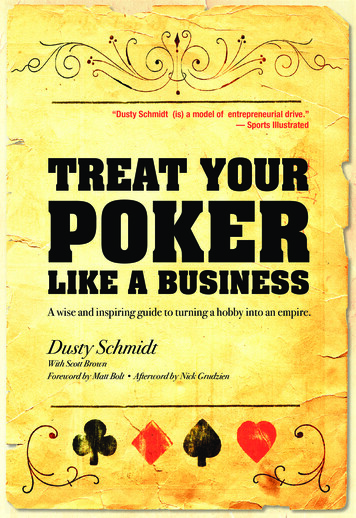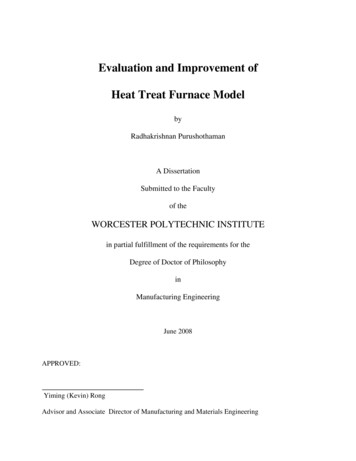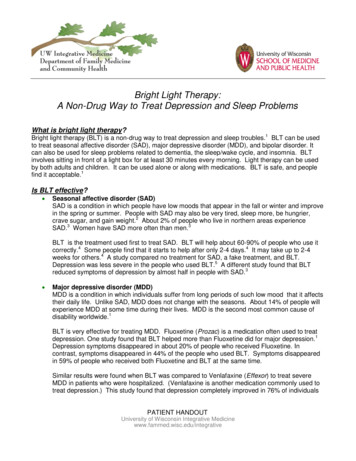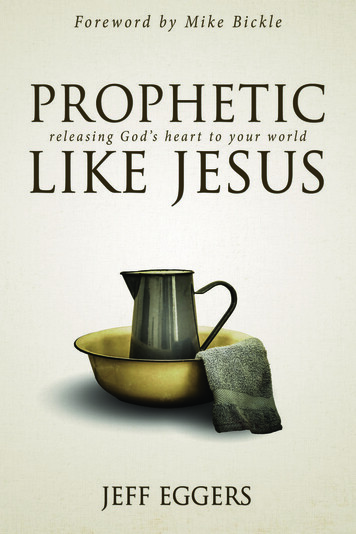
Transcription
!"# %&'()* ,-%''., /'0' 1-23'14''25%6276252#6,03'-6,829:';'(716% ' 33# %60%2-TREAT YOURPOKERLIKE A BUSINESS!"# %&"'()" (%* (,",- )&"./".- ( (,"'"0/112" (./"'("&3* &4!"# %&'()* , - )&'(. &/0.123.041.0,&5%&67 &/.8 &9&:; 401.0,&5%& ( & 0",? 42
TREAT YOUR POKERLIKE A BUSINESSAn inspiring guide to turning a hobby into an empireBY DUSTY SCHMIDTWITH SCOTT BROWNForeword by Matt BoltAfterword by Nick GrudzienImagine Media, LLCPortland San Francisco
2009 Imagine Media Trade Paperback EditionCopyright 2009 by Dusty Schmidt and Scott BrownAll rights reservedPublished in the United States by Imagine Media, LLCImagine Media is a trademark of Imagine Media, LLCLibrary of Congress Cataloging-in-Publication DataSchmidt, DustyTreat Your Poker Like A Business:An Inspiring Guide to Turning A Hobby Into An Empire,By Dusty Schmidt with Scott BrownISBN: ISBN 978-0-9843363-0-2Printed in the United States of Americawww.dustyschmidt.netBook Design by Tracy HopperWebsite Design by Jeff Conway
For all the small-stakes grinders out therelooking to get a break in life.May you never learn to shuffle.
ACKNOWLEDGMENTSI am deeply grateful for the following people, without whosecontributions, guidance and encouragement this book wouldnot have been possible: Nicole Schmidt, Matt Amen, NickGrudzien, Matt Bolt, Jared Tendler, Michael Skelton, Rob Wise,Casey Martin, Johnny Mac, Jim Pellegrino, Jim Varnon, TaylorCaby, Ed Miller, Alex Huang, Jim Galfano, Dan Deppen, JohnMcKenna, Daniel Briz, Derek Gardener, Andrew Brand, JohnnyWatkins, Doug “Pairadiddle” Kreisel, James Taylor, PGAPro,Jianhua Li, Steve Wilson, Steve Odeegan, Michael Ashley,Jeff Conway, Tracy Hopper, Sara Brown, Robert Fields, TomKnackstedt, Mike Ziethlow and Jeffrey Burkert.I would also like to thank the following online players, whohelped bring this book to the poker community: Tallskid,PokerTheorist, schaffem111, CHPokerBrat, KreativeDal,sandtiger, wilneedheart, AceSweaty, totals, SpiderJ, trigpoint,tiltboy, Boum, dzikiljack, kalebra, masterholmes, pokege,betapro, WhiteMass, folkdsb, BigEd157, imnuts, fink494,sisnarf, joeyg50, scotchMist, TheRaguu, Ketlar, joeaugie,HighOctane, npiv, somervillejoe.
CONTENTSForeword, by Matt BoltIntroduction713SECTION 1Treat Your Poker Like A Business1. A Game Of Skill, Not Luck2. Why I Kept It Simple3. Comparable Professions4. Are You In?5. Starting Thoughts6. Assigning A Value To Your Time7. Practicing Effectively8. Managing Your Bankroll9. Knowing Your Margins10. Metrics That Matter11. Dealing With Variance12. Don’t Look At The Cashier13. Knowing Your Risk Tolerance14. Pick A Strategy15. Time For Expansion16. Determining Your Style17. A Simple Approach To Adding Tables18. Knowing Your Expenses19. Protecting Your Capital20. Managing Your Emotions21. Why Psychology Matters22. Becoming A Grinder23. Mistake Hate2124272933354044485155606365687074767880848790
24. The Ten Most Overlooked Mistakes25. A New Set Of Results26. Pressure Can Be Good27. Having A Successful Relationship28. The Importance Of A Good Diet29. Goal Setting30. Staying Disciplined31. To Chat Or Not To Chat32. Location, Location33. Hours Of Operation34. Tournaments Or Cash Games?35. Equipping Your Computer For Maximum Profit36. The Importance Of Rakeback37. Taxes, Record Keeping And Their Impact On Bankroll38. Don’t Listen To The Critics39. Must Reads40. How Will I Know I’m Good Enough?41. Telling Them What You Do For A 139142SECTION 2StrategyTen Common Situations — And How To Play ThemFive Effective Plays That Are UnderutilizedIn Conclusion Afterword, by Nick Grudzien146179189194
FOREWORD!By Matt BoltThere are two things you need to know about Dusty Schmidt:1. He has no use for lazy. A lot of people get into pokerbecause they’re running away from something. Dusty is onlyinterested in people who are running toward something.2. Even though this book presents a structure for you to applyto your poker business, Dusty’s is not a one-size-fits-allphilosophy. He wants your game to evolve just as his did.Honestly, at the end of the day, I think what Dusty wants isfor people to be happy. Poker liberated him from a life hedidn’t want and opened doors to the one he did. I think hesees that possibility as existing for anyone who commits. Butmake no mistake: you have to commit. To Dusty, there’s ahigher standard than dollars won, and that’s the integrityof your effort. If that’s there, success will follow.I first met Dusty when I was selling pest-control services.Seriously. But it was actually the job I had before that — andhow I came to leave it — that I think made Dusty feel he couldwork with me.I graduated in Dec. 2005 from Winthrop University in RockHill, South Carolina, with a degree in management. I had mycommencement ceremonies on Saturday, and started work formy stepdad’s roofing company in Simpsonville on Monday.7
Since the age of 15, it had been preordained that I’d one daytake over the business.It was a great job by most any standard. My stepdad and I havea good relationship, and he created the job for me. There wasno interview, no resume. I had no set responsibilities, otherthan sitting in the office next to his, looking busy and waitingfor him to retire.Oddly, I found myself jealous of friends who had far worse jobsthan mine, because they’d earned the positions themselves. Iknew I was blessed. But I also knew I needed to do my own thing.So I took a job in outside sales for Orkin Pest Control. The salesexperience and freedom were big plusses; my jerk boss was a bigminus. Again, I found myself dissatisfied.At the time, I’d never have thought I’d end up playing poker fora living, even when I was confident in my ability to be a longterm winner. I’m conservative with my money, and I just felt Icouldn’t gamble to pay the bills.My brother had introduced me to online poker. I’d been playingand improving, but had massive issues with tilt and bankrollmanagement. I got a membership at Stoxpoker.com, which iswhere I first became aware of the legend of “Leatherass,” thegrinder who at that time was just coming off achieving PokerStars’ SuperNova Elite status in just eight months. His win ratioover massive sample sizes was totally unprecedented. I watchedall of Dusty’s videos and read his blogs. Being naïve, I sent hima private message venting about my frustrations with my game.8
I asked if he’d be willing to coach me.Dusty is fond of golf analogies, so I’ll use one here. It was basicallyas though he’d just come off winning a major championship,and here I was a 15-handicap asking for a lesson.I told him my story, and I think I struck him as someone whoreally wanted to learn and put in the work to be great — eventhough I didn’t envision poker as a profession at the time.He was very nice and made me feel better about my circumstance.While he said he didn’t have the time to work with me, his goodbuddy Matt Amen did. I eventually traveled to Las Vegas to meetMatt and Dusty at the World Series of Poker in June 2007 andwe hit it off really nicely.I’d been making 500- 1,000 a month playing a couple ofnights a week. Still, Matt hounded me to quit my job and playpoker full time. “Why do you go to work every day?” he asked.“It’s so stupid.” I had to admit, the freedom these guys seemedto enjoy was alluring. They were living the dream. Convinced,I left my job in late 2007, and was able to ratchet my earningsup to a modest 2,000- 3,000 a month playing .25/.50 NL.My expenses were 1,500, so I was getting by.But complacency was seeping in. Like the guys in the movie“Office Space,” my goal had been to not do anything I didn’twant to do. So I played video games, watched TV and went ontrips. I felt like a 13-year-old on summer vacation. I quicklyforgot that poker was my job, and I was falling woefully shy ofthe commitment I’d made to myself to play 30-40 hours a week.9
In Jan. 2008, I went on a terrifyingly bad run. I had no financialcushion, and I was genuinely scared I was going to have to get yetanother job to which I’d hate going every day.I called Dusty in February and convinced him I’d seen the errorin my ways. He said he’d be willing to work out a staking dealwith me. His idea was for me to move up in limits aggressivelyand not worry about bankroll — what was his was mine. At thatpoint, I’d never had 10,000 to my name.There were provisions to our deal. In hindsight, the businessoriented, workmanlike structure that Dusty provided me withinjected a great work ethic into my life that lasts today. Not onlywas I accountable to him; I was accountable to myself. I hadto play 16,000 hands per week minimum. I could fall shy oneweek, but if it happened again the deal was off. He would reviewall of my hands with me. He taught me how to read, review andcontemplate hands in my head. He also wanted me to email himfive questions a week on topics with which I’d been struggling.We’d talk them out and let our minds wander. It was reallyinvigorating. Now poker was at the center of my life, and nothingwas going to stop me.Because of his investment in me, I really wanted my results to begood. It would have been easier to lose my own money than tolose someone else’s, especially someone who’d been as good tome as Dusty had. I didn’t want to just mindlessly grind out hands.I wanted to make him money. There’s where my improvementcame from. It was that deal with Dusty, and his requiring me todo the necessary work, that made me what I am today.10
With no bankroll concerns, I went up to 1/2 NL right away. Iwas working diligently, and the results were immediate. Afterpeaking previously at 3,000, I had my first 10,000 monthin March. In April I made 20,000, and I made 30,000 inMay. In November, I had a 100,000 month.One problem I’d always had was leaving my results behind whenI was done playing. A bad session would ruin my day, even myweek.Dusty recommended I work with his performance coach, JaredTendler, whose thoughts on poker psychology also appear in thisbook. Jared helped me to rationalize variance and get over myissues with tilt. Now I can play longer and think more clearly.Most importantly, Dusty got me thinking about my game inabsolute business terms. My mentality when I lost, say, 5,000was to think, “What could I have done with that amount ofmoney? How could I have lost it?” But it was never my money.I needed money to make more money. I didn’t lose a nice TV — itwas never my money to begin with. Money was not money, it wasinventory. My bankroll was for buy-ins, not cars.My most telling moment with Dusty came not when I waswinning, but when I wasn’t. After taking in 30,000 in May2008, I went through a stretch of 100,000 hands where Ibroke completely even. Dusty was getting killed on our deal.I was playing 20 tables at 2/4 NL and 3/6 NL. I had a big fearof moving up to 5/10 NL — the notion of losing 1,000 on ahand of poker was too much for me to bear.11
Dusty called me and I was expecting him to say the deal was off.Instead, his reaction blew my mind. He said he didn’t want ourdeal to end, but he did want me to drop down in tables andmove up in limits. I’d made no money for 100,00 hands, butin true Dusty form, his answer wasn’t to just quit. Instead, weanalyzed things as business partners and found a better way.And as I mentioned before, we were both rewarded when I hada 100,000 month that November.Our games have diverged this past year. I have a bit more gamblein me, so I’ll play fewer tables, but do it at higher stakes. I domuch better when I’m challenging the limits. For him, themetric that matters is volume.But I continue to install the business practices he taught meat the outset. And I continue to go all out whenever I’m at thetables. As Dusty would tell you, putting in the hours is pointlessif the time spent isn’t quality time. Now I want to do everythingI can to maximize my expectations for the time that I play.You’re in good hands with Treat Your Poker Like A Business. WithDusty’s help, I’m in the business of trying to achieve my “A”game all the time.Matt Bolt is an instructor at Stoxpoker.com.12
!INTRODUCTIONThis book contains some of the most important poker strategyin print.A lot of people are going to hate it.They’ll hate it not for the 15 strategy tips you’ll find in Section2, but for the 41 chapters that precede them in Section 1 — theone titled “Treat Your Poker Like A Business.” The informationin this chapter is distinctly uncool. It is totally without tips onaggressive play, how to put your opponent on tilt, or how tomake great calls on big pots. You’ll not find a single bit of trashtalk or chest beating.Instead, these chapters are tied together by a simple theme: Weare here to make money. This is a business. Check your ego atthe door.In the simplest terms possible, this book tells you how to playbetter poker, and turn that improvement into money in yourpocket. Some view business concepts as being peripheral to longterm poker success. I see them as essential.There’s a knowledge gap in the poker world that I’m hoping tofill with this book. To me, running your poker like a business andplaying successful poker go hand in hand. Yet most people playpoker much better than they run a business. They have ability,but no clear way to monetize it.13
The modern poker player is like professional athletes werebefore agents came along. They played in stadiums packed tothe gills; meanwhile, they made 10,000 a year. Today’s playerknows he’s the attraction. Many ballplayers make more thanowners do. That’s because they learned how to monetize theirabilities. Because online poker is still very much in its infancy,the player who can turn his talents into money by running hispoker operation efficiently can be a veritable tycoon. The fact isthat some of the most important factors to your overall win ratehave nothing to do with actually playing the game of poker, butrather how well you run your poker business.I am a hu
to you r poker bu sin ess, D u styÕs is n ot a on e-size-fits-all ph ilosoph y. H e w an ts you r gam e to evolve ju st as h is did. Honestly, at the end of the day, I think what Dusty wants is for people to be happy. Pok er liber ated him from a life he didn Õt want and opened doors to the one he did. I think he sees that possibility as existin g for an yon e w ho com m its. B ut m ake n o .











